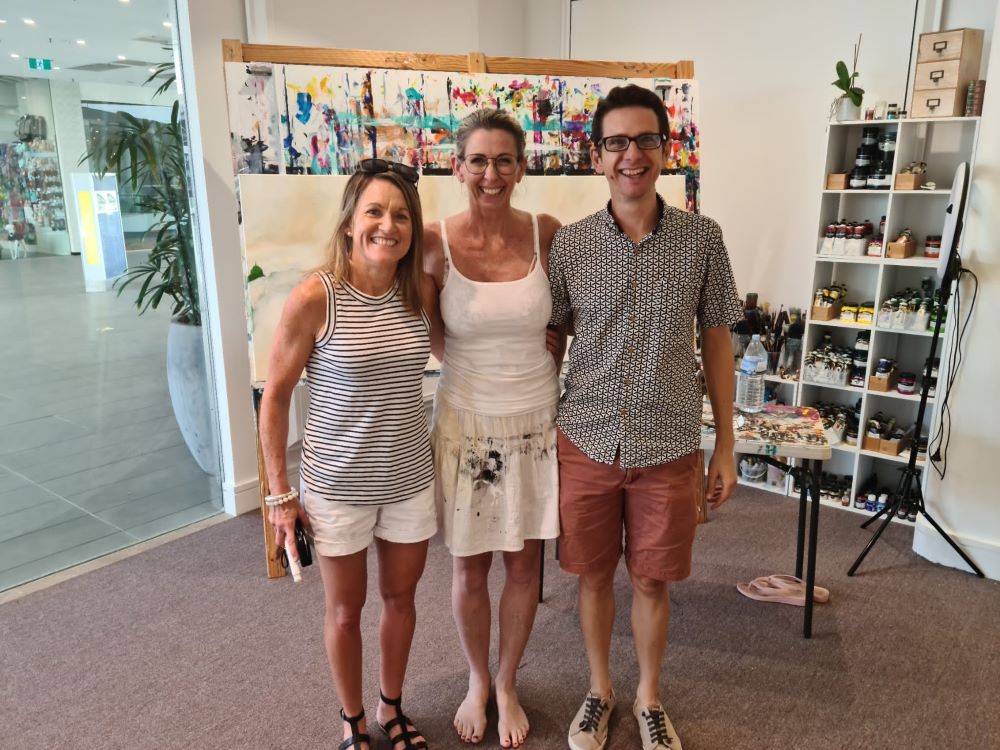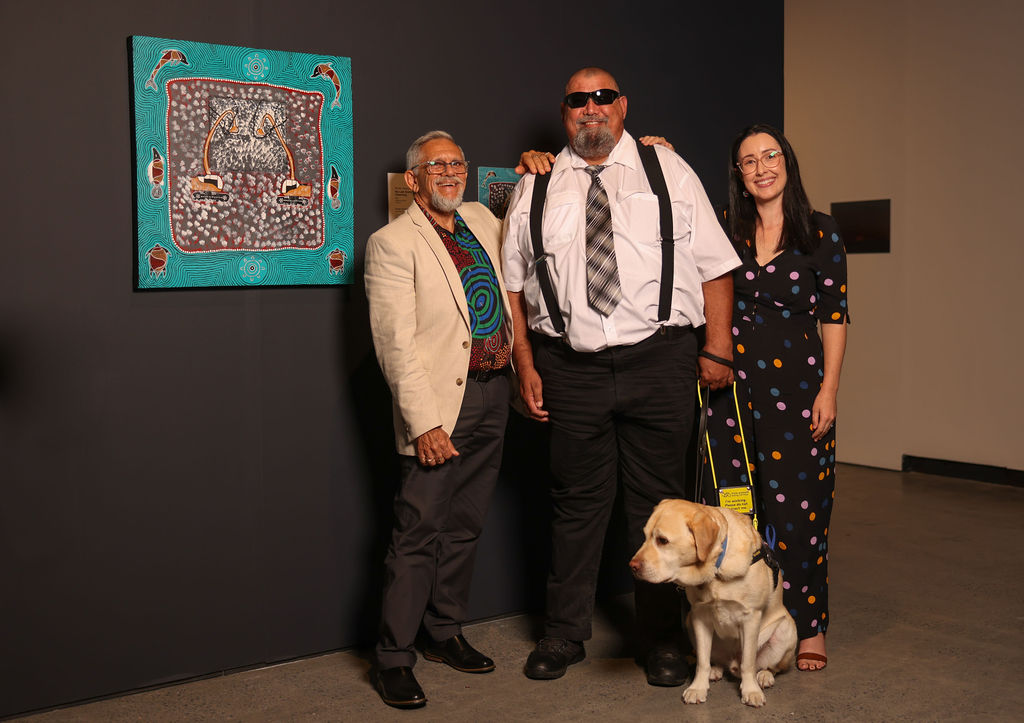
Art exhibition and concert pioneer new ways to experience and access the arts
- 24 Oct 2023
Last Seen utilised soundscapes, tactile art, short films and voice activated guides to assist the vision impaired in experiencing the arts
What
The Queensland Eye Institute Foundation (QEIF) wanted to raise the awareness of preventable eye disease and pioneer new ways for all, particularly the visually impaired, to experience and access the arts.
Last Seen featured a multi-sensory exhibition and concert performance presented by the QEIF in collaboration with Griffith University with an aim to highlight the value of sight and call attention to treatable conditions which lead to vision loss.
The Last Seen exhibition and concert addressed the important health challenge of vision-impairment and highlighted the important role the arts play in delivering positive social outcomes.
Last Seen featured ten vision impaired Australians from diverse backgrounds who shared their last or most cherished memories of sight with ten artists and ten composers. Participants included decorated blind veteran Michael Lyddiard, Paralympic Gold Medallist Katie Kelly OAM, classical pianist and policy and advocacy lead, Jane Britt, OAM-recipient and motivational speaker, Lorin Nicholson.
The artists, composers and musicians interpreted these memories through art.
The Last Seen exhibition enabled visitors to see, hear and feel through tactile art, short films, immersive soundscapes and a voice-activated guide, providing vision-impaired visitors with a truly engaging experience. Admission was free.
With the help of Vision Australia, the visually impaired interpreted artworks for themselves with tactile art that substitutes touch for sight. Using useful marking paint to make three dimensional tactile markings such as lines, dots, shapes or drawings, the art was felt by touch. Braille was also used to provide information that enhanced meaning for the visually impaired community.
The exhibition featured Queensland artists Robert Brownhall, Rick Everingham and Dylan Jones.
The Last Seen concert was a ticketed performance featuring Last Seen participants and composers Dr Jeff Usher and Lorin Nicholson and renowned composers Paul Jarman and Grammy award-winning Tim Davies. Works were performed by the Conservatorium Symphony Orchestra and Choir, and Voices of Birralee.
The Queensland Eye Institute Foundation previously presented Last Seen in 2019 as an exhibition only.
When and where
The Last Seen exhibition ran from 18 – 29 April 2023 at the Queensland College of Art, Brisbane. The Last Seen performance was held at the Queensland Conservatorium Griffith University on 21 April 2023.
Key stats
- 10 artists, composers and filmmakers paired with vision-impaired participants resulting in 30 individual works
- 3 activities
- 243 participants
- 7660 total attendees
- 100+ attendees with a disability
- 6000+ accessing the virtual art gallery
- 700 users directly engaging with the voiceskill app,
- 450 users watching films and accessing soundscapes
- 20 volunteers
- Multiple partnership and engagement opportunities including with the Braille House, Griffith University, Voices of Birralee, Brisbane City Council, Vision Australia, Southern Cross Austereo, Channel Nine, Beyond Payments, TalkVia and Alexa Australia
- More than $210,000 was raised from the sale of artworks, raffles and tickets

Investment
The Queensland Government, through Arts Queensland, supported the QEIF with funding of $33,112 through the Queensland Arts Showcase Program – Arts Advantage – round 7
Outcomes
Build a strong and sustainable sector
- The project offered opportunities for local artists, composers and filmmakers, particularly the emerging artists and those with a vision-impairment.
- The exhibition provided a unique leveraging opportunity for the artists and composers with the potential for new employment opportunities.
Drive social change and strengthen communities
- The project used the arts to highlight important social issues.
- Provided innovative platforms to share and better understand diverse perspectives.
- Strong engagement levels and participation in the multi-sensory experience. The aim of the multi-sensory experience is for people to explore and enjoy works through other senses.
Share our stories and celebrate our storytellers
- Showcased real life personal stories
Learnings and reflections
The ultimate outcome was to drive a change in attitudes and behaviours, and enable as many vision-impaired Australians to live engaged and fulfilling lives - like many of those participating in the unique exhibition. For many persons with a disability, particularly the vision impaired, the prospect of a visit to an art gallery can be a rather intimidating event.
There was strong qualitative feedback from the vision-impaired community, and engagement with stakeholders (Brisbane City Council and the Queensland College of Art) regarding improvements to exhibitions. This included tactile markings on the floor, brightness of lighting for the vision-impaired and the mounting height of tactile art, and the use of filmoform for braille guides.
All visitors were asked for their feedback, especially those with a vision impairment, in order to make any necessary accessibility changes immediately. The overall feedback regarding the performance was extremely positive.
Future considerations include the extension from a one-night performance to multiple nights and live-streaming the concert.
The Last Seen project is a reminder of the critical importance of eyesight as most Australians take their sight for granted, and this was achieved. 100% of all surveyed agreeing the project helped raise awareness of preventable eye disease and 81% agreeing the project made them think differently about accessibility in the arts sector.

Feedback
"As a totally blind person, I thought the exhibition was well done. I would like to be involved in something like this." Exhibition Visitor
"The layers of this exhibition are just so beautiful - every sense stimulated, like you were actually in the painting. Thank you so much to all involved." Exhibition Visitor
"Wonderful exhibition. Intruiged by the tactile art, curious, how is it achieved? Opening access for vision and vision impaired sharing of art together." Exhibition Visitor
"Occasionally, an extra special project like this one crosses my desk and brings warmth and fresh perspective to making art and connecting with the community" Lisa Cheney, Composer.
"This has been profound. Beyond my wildest expectations of what this would culminate to be when I started it. A moment in time, come and gone, fleeting and impactful. However, my Last Seen is now publicly in music, in art, in video, however mostly privately in mind, and it’s mine to keep, forever. When my vision fades, I’ll return here, in solace." Jane Britt Vision-Impaired Participant.
"So proud to have been a part of this amazing and inspiring event! Thanks to the team at QEI for making this happen". Larry Prosser, Beyond Payments
"Really good for accessibility with tactile art and braille guide," Nartbethong School teacher
Tips for others
Ask all visitors for feedback, especially those with a vision impairment, in order to immediately make any necessary accessibility changes or adjustments.
What next?
With the funds raised from Last Seen, QEIF will create Queensland’s first genetic eye diseases register to connect patients with clinical trials. QEIF will also use the funds to develop electrophysiological testing capabilities to aid the diagnosis of genetic eye diseases.
Find out more
The Queensland Eye Institute Foundation (QEIF) is the state’s largest independent academic research institute devoted to eye-related health and diseases. The Foundation’s mission is to reduce eye disease, improve eye health, and ultimately eliminate preventable blindness in the community. Proceeds from the project help the Foundation continue its research to save sight.



